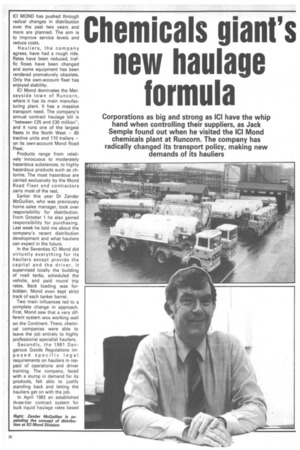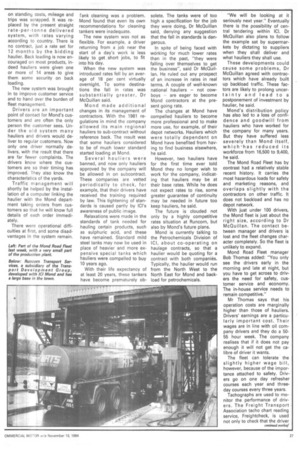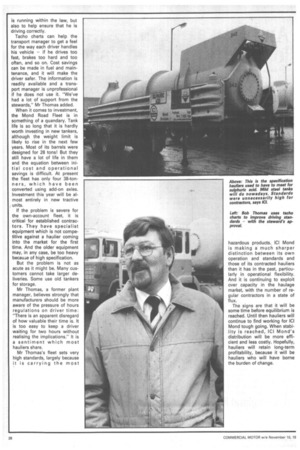Chemicals giant's new haulage formula
Page 28

Page 29

Page 30

If you've noticed an error in this article please click here to report it so we can fix it.
Corporations as big and strong as ICI have the whip hand when controlling their suppliers, as Jack Semple found out when he visited the ICI Mond chemicals plant at Runcorn. The company has radically changed its transport policy, making new demands of its hauliers
ICI MOND has pushed through radical changes in distribution over the past two years and more are planned. The aim is to improve service levels and reduce costs.
Hauliers, the company agrees, have had a rough ride. Rates have been reduced, traffic flows have been changed and some equipment has been rendered prematurely obsolete. Only the own-account fleet has enjoyed stability.
ICI Mond dominates the Merseyside town of Runcorn, where it has its main manufacturing plant. It has a massive transport need. The company's annual contract haulage bill is "between £25 and £30 million", and it runs one of the largest fleets in the North West — 85 tractive units and 110 trailers — on its own-account Mond Road Fleet.
Products range from relatively innocuous to moderately hazardous substances, to highly hazardous products such as chlorine. The most hazardous are carried exclusively by the Mond Road Fleet and contractors .carry most of the rest.
Earlier this year Dr Zander McQuillan, who was previously home sales manager, took over responsibility for distribution. From October 1 he also gained responsibility for purchasing. Last week he told me about the company's recent distribution development and what hauliers can expect in the future.
In the Seventies ICI Mond did virtually everything for its hauliers except provide the capital and the driver. It supervised totally the building of road tanks, scheduled the vehicle, and paid round trip rates. Back loading was forbidden. Mond even kept strict track of each tanker barrel.
Two main influences led to a complete change in approach. First, Mond saw that a very different system wos working well on the Continent. There, chemical companies were able to leave the job entirely to highly professional specialist hauliers.
Secondly, the 1981 Dangerous Goods Regulations imposed specific legal requirements on hauliers in respect of operations and driver training. The company, faced with a slump in demand for its products, felt able to justify standing back and letting the hauliers get on with the job.
In April 1983 an established three-tier contract system for bulk liquid haulage rates based on standing costs, mileage and trips was scrapped. It was replaced by the present straight rate-per-tonne delivered system, with rates varying according to country. There is no contract, just a rate set for 12 months by the bidding haulier. Back loading is now encouraged on most products, indeed hauliers were given one or more of 14 areas to give them some security on back loading.
The new system was brought in to improve customer service and to hand over the burden of fleet management.
Drivers are an important point of contact for Mond's customers and are often the only person the customer sees. Under the old system many hauliers and drivers would deliver to regular customers. Now only one driver normally delivers, with the result that there are far fewer complaints. The drivers know where .the customers are so their timing has improved. They also know the characteristics of the yards.
Traffic management will shortly be helped by the installation of a computer linking the haulier with the Mond department taking orders from customers so that he will know full details of each order immediately.
There were operational difficulties at first, and some disadvantages in the system remain. tank cleaning was a problem. Mond found that even its own recommendations for cleaning tankers were inadequate.
The new system was not as flexible. For example, a driver returning from a job near the start of a day's work is less likely to get short jobs, to fit into his day.
When the new system was introduced rates fell by an average of 18 per cent virtually overnight. To some destinations the fall in rates was substantially greater, Dr McQuillan said.
Mond made additional changes in its management of contractors. With the 1981 regulations in mind the company allowed its main regional hauliers to sub-contract without reference back. The result was that some hauliers considered to be of much lower standard started loading at Mond.
Several hauliers were banned, and now only hauliers approved by the company will be allowed in on subcontract. These companies are vetted periodically to check, for example, that their drivers have received the training required by law. This tightening of standards is caused partly by ICI's awareness of public image.
Relaxations were made in the standards of tank needed for hauling certain products, such as sulphuric acid, and these have remained. Standard mild steel tanks may now be used in place of heavier and more expensive special tanks which hauliers were compelled to buy 10 years ago.
With their life expectancy of at least 20 years, these tankers have become prematurely ob solete. The tanks were of too high a specification for the job they were doing, Dr McQuillan said, denying any suggestion that the fall in standards is dangerous.
In spite of being faced with working for much lower rates than in the past, "they were falling Over themselves to get the business", said Dr NIcQuilIan. He ruled out any prospect of an increase in rates in real terms. A couple of well-known national hauliers — not cowboys — are eager to become Mond contractors at the present going rate.
The changes at Mond have compelled hauliers to become more professional and to make more use, for example, of their depot networks. Hauliers which were totally dependent on Mond have benefited from having to find business elsewhere, he said.
However, two hauliers have for the first time ever told Mond they no longer wish to work for the company, indicating that hauliers may be at their base rates. While he does not expect rates to rise, some greater guarantee of continuity may be needed in future too keep hauliers, he said.
The future is clouded not only by a highly competitive rates situation at Runcorn, but also by Mond's future plans.
Mond is currently talking to the Petrochemicals Division of ICI, about co-operating on haulage contracts, so that a haulier would be quoting for a contract with both companies. Typically, the haulier would run from the North West to the North East for Mond and backload for petrochemicals. "We will be looking at it seriously next year." Eventually there is the possibility of central tendering within ICI. Dr McQuillan also plans to follow the example set by supermarkets by dictating to suppliers when they shall deliver and what hauliers they shall use.
These developments could cause some problems, Dr McQuillan agreed with contractors which have already built up backload traffic. These factors are likely to prolong uncertainty and lead to a postponement of investment by haulier, he said.
Mond's distribution jpolicy has also led to a loss of confidence and goodwill from hauliers who have worked for the company for many years. But they have suffered less severely than Mond itself, which 'has reduced its workforce from 16,500 to 9,400, he said.
The Mond Road Fleet has by contrast had a relatively stable recent history. It carries the most hazardous loads for safety and marketing reasons, and overlaps slightly with the contractors on other traffic. It does not backload and has no depot network.
With just under 100 drivers, the Mond fleet is just about the right size, according to Dr McQuillan. The contact between manager and drivers is lost and the fleet changes character completely. So the fleet is unlikely to expand.
Mond Road Fleet manager Bob Thomas added: "You only see the drivers early in the morning and late at night, but you have to get across to drivers the need for safety, customer service and economy. The in-house service needs to remain competitive."
Mr Thomas says that his operation costs are marginally higher than those of hauliers. Drivers' earnings are a particularly important cost. Their wages are in line with oil company drivers and they do a 5055 hour week. The company realises that if it does not pay enough it will not get the calibre of driver it wants.
The fleet can tolerate the slightly higher wage bill, however, because of the importance attached to safety. Drivers go on one day refresher courses each year and threeday courses every three years.
Tachographs are used to monitor the performance of drivers. The Freight Transport Association tacho chart reading service, Freightcheck, is used not only to check that the driver is running within the law, but also to help ensure that he is driving correctly.
Tacho charts can help the transport manager to get a feel for the way each driver handles his vehicle — if he drives too fast, brakes too hard and too often, and so on. Cost savings can be made in fuel and maintenance, and it will make the driver safer. The information is readily available and a transport manager is unprofessional if he does not use it. "We've had a lot of support from the stewards," Mr Thomas added.
When it comes to investment, the Mond Road Fleet is in something of a quandary. Tank life is so long that it is hardly worth investing in new tankers, although the weight limit is likely to rise in the next few years. Most of its barrels were designed for 28 tons] But they still have a lot of life in them and the equation between initial cost and operational savings is difficult. At present the fleet has only four 38-tonners, which have been converted using add-on axles. Investment this year will be almost entirely in new tractive ; units.
If the problem is severe for the own-account fleet, it is critical for established contractors. They have specialist equipment which is not competitive against a haulier coming into the market for the first time. And the older equipment may, in any case, be too heavy because of high specification.
But the problem is not as acute as it might be. Many customers cannot take larger deliveries. Some use old tankers for storage.
Mr Thomas, a former plant manager, believes strongly that manufacturers should be more aware of the pressure of hours regulations on driver time: "There is an apparent disregard of how valuable their time is. It is too easy to keep a driver waiting for two hours without realising the implications." It is a sentiment which most hauliers share.
Mr Thomas's fleet sets very high standards, largely because it is carrying the most hazardous products. ICI Mond is making a much sharper distinction between its own operation and standards and those of its contracted hauliers than it has in the past, particularly in operational flexibility. And it is continuing to exploit over capacity in the haulage market, with the number of regular contractors in a state of flux.
The signs are that it will be some time before equilibrium is
reached. Until then hauliers will continue to find working for ICI Mond tough going. When stability is reached, ICI Mond's distribution will be more efficient and less costly. Hopefully, hauliers will retain long-term profitability, because it will be hauliers who will have borne the burden of change.




































































































